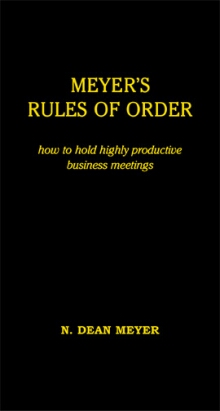| Excerpt from www.NDMA.COM, © 2025 N. Dean Meyer and Associates Inc.
Pocket Book:
Meyer's Rules of Order
how to hold highly productive business meetings
by N. Dean Meyer
A little pocket book of simple, pragmatic guidelines that can dramatically improve the effectiveness of all business meetings; includes an effective method for consensus decision making. Most people spend a lot of time in meetings, and most complain about their ineffectiveness. Are there "rules of order" that can make meetings more productive? Imagine this: You walk into your first meeting of the morning -- only a few minutes late -- to find your colleague pounding a gavel on the conference room table to call the meeting to order, or asking if anyone "seconds" a motion. Ridiculous, right!? Robert's Rules of Order made an immense contribution to the effectiveness of legislative processes. But it was not designed for modern business meetings. For example, not every decision is made by majority rule. In business, consensus is often needed; or in some cases, the boss must decide. Furthermore, we've learned a lot since General Henry M. Robert published his rules in 1907 about how to run effective meetings, how groups can come to closure on decisions, and how to ensure follow up. And finally, 200 pages of parliamentary rules are more than any executive group has patience for!
This short booklet proposes a new set of rules of order -- a few dozen straightforward behaviors that can make meetings highly productive and effective. Not only is it designed for a business environment. It is more comprehensive, capturing what we've learned in the generations since Robert's Rules were first published. All the principles in this book are behaviors. They are carefully worded to be actionable by everyone. Thus, they can be taught, modeled, and measured. This is not theoretical; it's a working document. With these principles, the number of meetings can be reduced, the time they take can be constrained, frustration can be relieved, and the results can be far more satisfying. Where might you use these rules? In any meeting, for any purpose, however short or long, wherever it is held. Carry this booklet with you. Review it whenever you're feeling frustrated. Look for the principle that will resolve the problem. By using it as a working tool, over time these behaviors will become second nature, and you'll replace frustration with enthusiasm for meetings well run. Format: pocket book, 23 pages. $4.95 US Table of Contents....
Foreword — 1 1. Calling a Meeting — 5 2. Before the Meeting — 7 3. Starting a Meeting — 8 4. During the Meeting — 9 5. Making Decisions — 13 6. Ending the Meeting — 16 7. Missing a Meeting — 17
|



